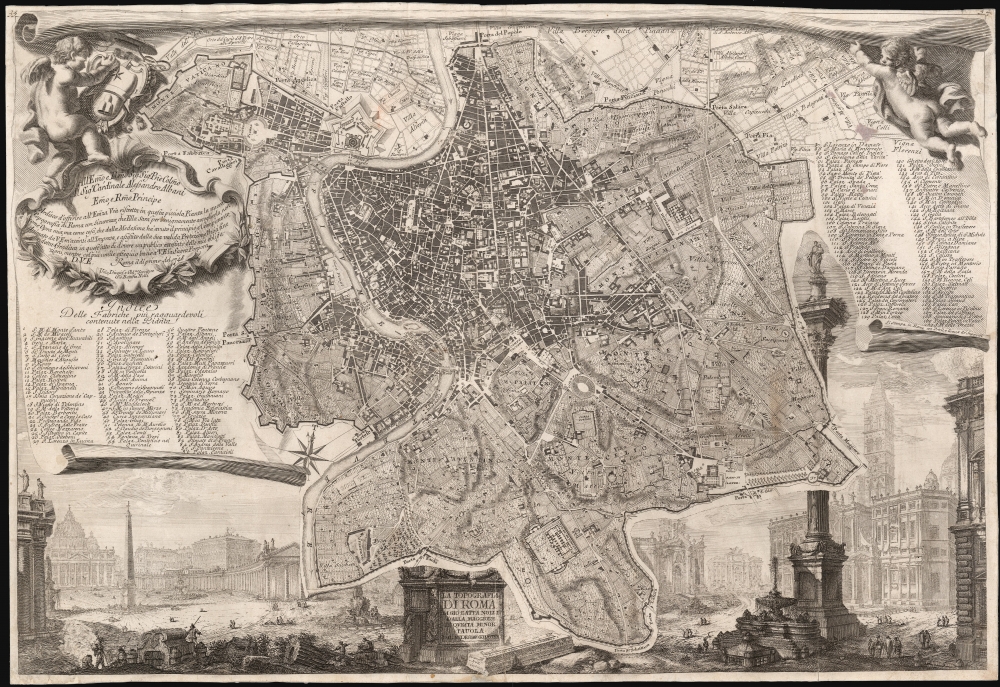This item has been sold, but you can get on the Waitlist to be notified if another example becomes available, or purchase a digital scan.
1748 Nolli / Piranesi Plan of the City of Rome
Rome-nollipiranesi-1748
Title
1748 (dated) 18 x 26.25 in (45.72 x 66.675 cm) 1 : 11,500
Description
Nolli's Accomplishment
Nolli's wall map ranks among the best plans ever produced of any city. It was the first plan of Rome that was produced on geodesic principles. It presents the city in astonishing detail, from the Villa Pamphili to the Tempio di Venere e Cupido and from the Vatican to the Porta San Sebastiano. Commissioned by Pope Benedict XIV to contextualize the formal demarcations between Rome's fourteen Rioni (traditional districts dating to the 12th century), Nolli's plan was impressive not only for its scale and accuracy, but because it is an ichnographic plan - showing the accurate dimensions of the city's structures, walls, columns, doorways, interior passages, and even staircases in minute detail. With incredible accuracy, Nolli even captured the asymmetry of the Spanish Steps. This smaller plan necessarily loses some of the detail of its larger sibling. Still, the masterful engraving nevertheless achieves impressive detail, and Piranesi's superb architectural views rank this map among the most desirable printed depictions of the Eternal City.Publication History and Census
This map was created by Nolli and Piranesi in 1748 to accompany bound editions of Nolli's multi-sheet map. The bound wall map folio is well-represented in institutional collections. Separate examples of this smaller single sheet appear in a handful of OCLC entries, and it appears on the market from time to time.CartographerS
Giambattista Nolli (April 9, 1701 – July 1, 1756) was an Italian cartographer and architect w active in the first half of the 18th century. Born in Como, Nolli moved to Rome under the patronage of the Albani and Corsini families. Most famous as the cartographer of his iconic 1748 plan of Rome, Nolli's architectural projects included work on the churches of Sant'Alessio on the Aventine Hill (1743) and Santa Dorotea in Trastevere (1751–1756). More by this mapmaker...
Giovanni Battista Piranesi (October 4, 1720 - November 9, 1778) was an Italian artist famous for his etchings of Rome and fictitious ‘prisons’. He was born in Mogliano Veneto, which was part of the Republic of Venice. He learned his trade (Piranesi considered himself an architect) from his father, a stonemason and master builder, his uncle, who taught him structural and hydraulic engineering, an his brother, a Carthusian monk, who inspired Piranesi’s fascination with history and the ancient Romans.
After Piranesi arrived in Rome in 1740, he briefly served as an apprentice to Giuseppe Vasi, who is recognized as the foremost producer of etchings of Rome, meant for pilgrims, scholars, artists, and tourists alike. Creating etchings provided Piranesi with a way to satisfy all of his interests, from designing fantastically complex structures that could only exist in his imagination, to reconstructing the ruins of ancient Rome. His archaeological prints, published in his Antichità Romane in 1756, allowed him to be elected to the Society of Antiquarians in London. He began working on his best known works, the Vedute di Roma (Views of Rome) by 1747, and would continue adding to the series until his death in 1778.
Piranesi is also celebrated for his series known as The Prisons (Carceri d’invenzione, ‘Imaginary Prisons’). These are fantastic, labyrinthine structures of epic proportions. He began working on the series in 1745, and the first state prints, which included fourteen etchings, were published in 1750 and were untitled and unnumbered. The second publishing in 1761 was formatted differently. This series included sixteen etchings, all of this were reworked and numbered I-XVI (1-16). Numbers II and V were new to the series. Though the series remained untitled, each of the sixteen etchings now is attached to a ‘conventional’ title. Learn More...

